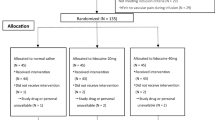Abstract
Circulatory stability and plasma levels of lidocaine were investigated in 20 patients who received thoracic epidural analgesia with plain lidocaine during elective abdominal surgery under general anesthesia. In one group, bolus injection of 8 ml of 2% lidocaine was followed by volumetric continuous pump-driven infusion (CPI) of 8 ml of 1.5% lidocaine per hour. In the other group, the same initial bolus injection was followed by repetitive intermittent bolus infusions (RII) of 6 ml of 1.5% lidocaine at a 45 min-interval. Circulatory stability was evaluated by a discriminant function. The results showed that epidural analgesia produced smaller circulatory fluctuations with CPI than with RII. Venous plasma lidocaine levels were consistently higher with CPI than with RII. Plasma levels increased stepwise with RII and kept constant with CPI. Differences in plasma levels were significant from 20 min after the initial injection to 135 min. We therefore conclude that epidural analgesia with CPI is superior to that with RII. However, it must be remembered that higher plasma levels may occur with CPI than with RII.
Similar content being viewed by others
References
Armitage EN: Lumbar and thoracic epidural anaesthesia, Principles and practice of regional anaesthesia. Edited by Wildsmith JAW, Armitage EN. Edinburgh, Churchill Livingstone, 1987, pp. 81–102
Tucker GT, Mather LE: Properties, absorption, and disposition of local anesthetic agents, Neural blockade. Edited by Cousins MJ, Bridenbaugh PO. Philadelphia, Lippincott, 1988, pp. 58–77
Tucker GT, Mather LE: Clinical pharmacokinetics of local anaesthetics. Clin Pharmacokinetics 4:241–278, 1979
de Jong RH: Absorption, binding, and disposition, Local anesthetics. Edited by de Jong RH. Springfield, Charles C Thomas publisher, 1977, pp. 180–189
Zador G, Willdeck-Lund G, Nilsson BA: Continuous drip lumbar epidural anaesthesia with lidocaine for vaginal delivery. Acta Obstet Gynecol Scand (Suppl) 34:31–40, 1974
Abboud TK, Afrasiabi A, Sarkis F, Daftarian F, Nagappala S, Noueihed R, Kuhnert BR, Miller F: Continuous infusion epidural analgesia in parturients receiving bupivacaine, chloroprocaine or lidocaine — maternal, fetal and neonatal effects. Anesth Analg 63:421–428, 1984
Hanson B, Matouskova-Hanson A: Continuous epidural analgesia for vaginal delivery in Sweden. Report of a nationalwide inquiry. Acta Anaesthesiol Scand 29:712–715, 1985
Scott DB: Acute pain management. Neural blockade in clinical anesthesia and management of pain. Cousins MJ, Bridenbaugh PO. Philadelphia, Lippincott, 1988, pp. 861–883
Takasaki M, Oh-oka T, Doi K, Kosaka Y: Blood levels of mepivacaine during continuous epidural anesthesia. Anesth Analg 66:337–340, 1987
Momose T, Ito K, Enomoto N, Yogozawa T, Yamada M, Kuge T: Comparison between pentazocine and buprenorphine in analgesic-supplemented anesthesia. Masui (Jpn J Anesthesiol) 30:1053–1061, 1981
Kawamoto M, Sera A, Niinai H, Tanaka H, Terasawa C, Ohta H, Kishida M, Horimoto S: Plasma lidocaine concentrations and pharmacokinetic analysis during epidural and general anesthesia. Hiroshima J Anesth 25:225–228, 1989
Stephan GW, Lees MM, Scott DB: Cardiovascular effects of epidural block combined with general anaesthesia. Br J Anaesth 41:933–938, 1969
Bonica JJ, Berges PD, Morikawa K-I: Circulatory effects of peridural block. I. Effects of level of analgesia and dose of lidocaine. Anesthesiology 33:619–626, 1970
Couosins MJ, Bromage PR: Epidural neural blockade, Neural blockade in clinical anesthesia and management of pain. Edited by Cousins MJ, Bridenbaugh PO. Philadelphia, Lippincott, 1988, pp. 274–292
Zador G, Willdeck-Lund G, Nilsson BA: Low dose intermittent epidural anesthesia with lidocaine for vaginal delivery. I. Clinical efficacy and lidocaine concentrations in maternal, foetal, and umbilical cord blood. Acta Obstet Gynecol Scand (Suppl) 34:3–16, 1974
Moore DC, Bridenbaugh LD, Bagdi PA, Bridenbaugh PO: Accumulation of mepivacaine hydrochloride during caudal block. Anesthesiology 29:585–588, 1968
Moore DC, Bridenbaugh LD, Bridenbaugh PO, Tucker GT: Caudal and epidural blocks with bupivacaine for childbirth. Report of 657 parturients. Obstet Gynecol 37:667–676, 1971
Abboud TK, Sarkis F, Blikian A, Varakian L: Lack of adverse neurobehavioral effects of lidocaine. Anesth Analg 62:473–478, 1983
Scanlon JW, Ostheimer GW, Lurie AO, Brown WU, Weiss JB, Alper MH: Neurobehavioral responses and drug concentrations in newborn after maternal epidural anesthesia with bupivacaine. Anesthesiology 45:400–405, 1976
Kuhnert BR, Kuhnert PM, Prochaska AL, Gross TL: Plasma levels of 2-chloroprocaine in obstetric patients and their neonates after epidural anesthesia. Anesthesiology 53:21–25, 1980
Author information
Authors and Affiliations
About this article
Cite this article
Kawamoto, M., Sera, A., Tanaka, H. et al. Circulatory stability and plasma lidocaine levels during continuous and intermittent thoracic epidural analgesia. J Anesth 5, 166–171 (1991). https://doi.org/10.1007/s0054010050166
Received:
Accepted:
Issue Date:
DOI: https://doi.org/10.1007/s0054010050166




